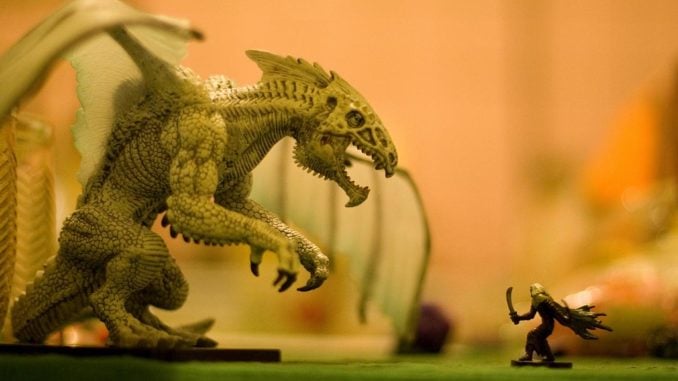
In past versions of Dungeons and Dragons, the rules allowed for a near-certain ability to kill a helpless opponent. Known as a Coup de Grace, the mechanic for this slaying was written into the rules. This specific mechanic was left out of 5E, however. But fear not! The game mechanics still address taking out a helpless opponent, albeit a little indirectly. To get the scoop, see our Coup de Grace 5E Guide.
Table of Contents
How Coup de Grace worked in 3.5
In 3.5, Coup de Grace was simple. One full-round action could automatically kill a helpless opponent in many cases. Using a melee weapon, bow, or crossbow, the attacker would simply make a full-round attack which automatically registered as a critical hit. The defender must then make a Fortitude save; if they fail, they die. The one caveat was that it was impossible to use Coup de Grace against a creature that was immune to critical hits.
How Does Coup de Grace Work in 5E?
If you search through your 5th Edition Player’s Handbook, you will find no mention of the Coup de Grace mechanic. Be that as it may, a form of the mechanic still exists. From barbarians to forge clerics, these mechanics apply to every class and race. Understanding how the unofficial form of Coup de Grace works in 5E requires knowledge of some basic game concepts, including incapacitation, death savings throws, and advantage.
- These rules apply to creatures that are essentially out of the fight. This includes those that are unconscious or paralyzed.
- You gain Advantage in all attacks against an unconscious or paralyzed opponent.
- All hits on incapacitated opponents within 5 feet are critical.
Remember, unconscious creatures fall prone. While you gain advantage in attacks against unconscious creatures, you get disadvantage with ranged attacks against prone creatures. These two effects cancel each other out if you make a ranged attack against an unconscious prone creature, resulting in a straight attack roll.
Helpless Creatures
There are a number of conditions a character in 5E can be in. For our purposes, unconscious and paralyzed are the ones you need to understand. An unconscious or paralyzed creature cannot take any actions or reactions. Anyone attacking an incapacitated creature always has advantage (unless they attack from range), and their hits are critical if they take place within 5 feet of the opponent.
Advantage
As discussed above, you gain an advantage any time you attack an incapacitated opponent. This is true if you are attacking someone right in front of you with a melee weapon or firing an arrow at them hundreds of yards away.
Advantage (and its counterpart, disadvantage) is a situational rule that comes into play on some attack rolls, saving throws or ability checks. In these situations, you roll the D20 twice instead of once. When you have an advantage, the highest of the two throws is your official roll. With disadvantage, you take the lowest of the two rolls. This means with an advantage you are far more likely to end up with a favorable roll than normal.
Death Saving Throws
The Player’s Handbook explains a death saving throw as:
Whenever you start your turn with 0 hit points, you must make a special saving throw, called a death saving throw, to determine whether you creep closer to death or hang onto life. Unlike other saving throws, this one isn’t tied to any ability score.
A roll of 10 or higher is a success; 9 or below is a failure. Three successes and you are stabilized and can act normally, despite having 0hp. Three failures and you die. A roll of 20 means you have stabilized, while a roll of 1 adds two failures. A DM can apply these rules to helpless opponents if they choose to do so. With the rules we described above, it is not difficult to tip the scales toward three failures.
Final Thoughts on the Lack of Coup de Grace in 5E
Sure, the ability to Coup de Grace a hapless opponent made things simple in older editions of dungeons and dragons. That said, I am pretty fond of the way helpless opponents are dealt with in 5E. In previous editions, automatically slaying a foe in the heat of battle seems a little overpowered. Sure, they can’t fight back. But in a chaotic situation, it is entirely possible your character might slip or make a mistake while keeping one eye on the battlefield. While the lack of Coup de Grace in 5E might frustrate some players, I think it is a valuable edition.
It is worth noting, however, that we are free to deviate from the Player’s Handbook. After all, making a roll to kill an unconscious opponent makes more sense on a battlefield than it does in an empty room with a single unconscious creature. If a situation feels like a roll would be pointless, ask your DM. It is possible they will simply narrate the kill and let you move on with your adventure. If you’re looking for more helpful guides on basic D&D mechanics, check out our explanation of Starting Gold in 5E.




Be the first to comment